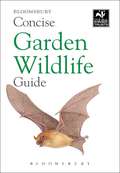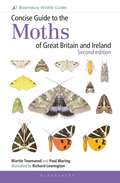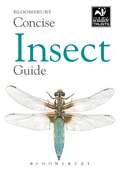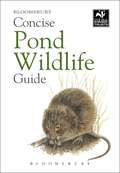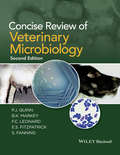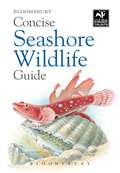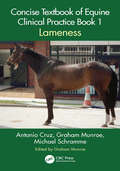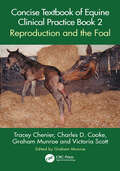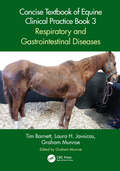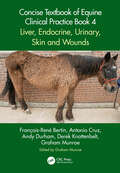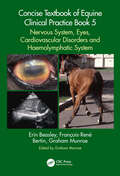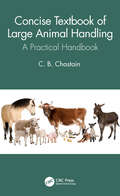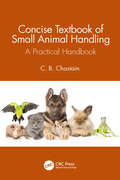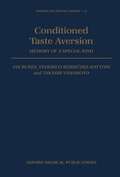- Table View
- List View
Concise Garden Wildlife Guide
by BloomsburyThis beautifully illustrated concise guide is packed with information on the wildlife that can be found in Britain and the near Continent, including mammals, birds, reptiles, amphibians, insects, molluscs, and crustaceans. It covers around 200 species, all of which are illustrated with superb full-colour artworks. A concise written account covering size, description, voice, habitat, distribution and habits appears on the same page as the illustration for each species. The easy-to-follow layouts and superb artworks aid quick and accurate identification, and make this book an invaluable reference outdoors as well as at home.To protect it against the elements, the book is wrapped in a durable plastic wallet. Also included is a fold-out insert illustrating differences between similar species, and assisting in quick identification.Renowned natural history artists Sandra Doyle, Stuart Carter, David Daly and Lyn Wells painted the illustrations.
Concise Guide to the Moths of Great Britain and Ireland: Second edition
by Martin Townsend Paul Waring'A remarkable field guide ... one of those books that come along every now and then and cause a revolution.'Michael McCarthyIndependentThis concise guide is a companion to the main Field Guide to the Moths of Great Britain and Ireland by the same expert authors, but is in a condensed form with artwork opposite the species descriptions and lay-flat binding for ease of use in the field. It includes brief but comprehensive field descriptions of all the macro-moths in Great Britain, Ireland, the Isle of Man and the Channel Islands, and this second edition has been thoroughly revised and updated to reflect the latest advances in taxonomy. Featuring more than 1,700 superbly detailed colour artworks and covering nearly 900 species, this portable guide is an essential addition to every moth-lover's field kit.
Concise Insect Guide
by BloomsburyThis beautifully illustrated pocket field guide is packed with information on the marvellous variety of insects that inhabits Britain and the near Continent. It includes more than 180 species, including dragonflies, bees, wasps, beetles, bugs and flies, all of which are illustrated with superb full-colour artworks. A concise written account covering size, description, habitat, distribution, foodplants and habits appears on the same page as the illustrations for each species. The easy-to-follow layouts and superb artworks aid quick and accurate identification, and make this book an indispensable reference in the field as well as at home.Renowned natural history artists Sandra Doyle and Stuart Carter painted the illustrations.
Concise Insect Guide
by BloomsburyThis beautifully illustrated pocket field guide is packed with information on the marvellous variety of insects that inhabits Britain and the near Continent. It includes more than 180 species, including dragonflies, bees, wasps, beetles, bugs and flies, all of which are illustrated with superb full-colour artworks. A concise written account covering size, description, habitat, distribution, foodplants and habits appears on the same page as the illustrations for each species. The easy-to-follow layouts and superb artworks aid quick and accurate identification, and make this book an indispensable reference in the field as well as at home.Renowned natural history artists Sandra Doyle and Stuart Carter painted the illustrations.
Concise Pond Wildlife Guide
by BloomsburyThis beautifully illustrated mini field guide is packed with information on more than 190 species of animal and plant that inhabit still-water bodies such as ponds, pools and small lakes in northern Europe. A vast number of species occurs in these habitats, so the book is selective, but it pictures and describes a good range of fauna and flora that are likely to be found and identified. Among the fascinating animals featured are freshwater sponges, hydras, water bears, worms, leeches, water snails, dragonflies and damselflies, frogs and toads, bats, fish, birds, and iconic mammals such as the Water Vole and European Otter. All the species are illustrated with superb full-colour artworks, and a concise written account for each covers data such as size, general description, habitat, ecology, and distribution in Britain and the near Continent. The easy-to-follow layouts and superb artworks aid quick and accurate identification, making the book an indispensable reference in the field as well as in the home and garden. It is wrapped in a durable plastic wallet to protect it against the elements in the field.
Concise Pond Wildlife Guide
by BloomsburyThis beautifully illustrated mini field guide is packed with information on more than 190 species of animal and plant that inhabit still-water bodies such as ponds, pools and small lakes in northern Europe. A vast number of species occurs in these habitats, so the book is selective, but it pictures and describes a good range of fauna and flora that are likely to be found and identified. Among the fascinating animals featured are freshwater sponges, hydras, water bears, worms, leeches, water snails, dragonflies and damselflies, frogs and toads, bats, fish, birds, and iconic mammals such as the Water Vole and European Otter. All the species are illustrated with superb full-colour artworks, and a concise written account for each covers data such as size, general description, habitat, ecology, and distribution in Britain and the near Continent. The easy-to-follow layouts and superb artworks aid quick and accurate identification, making the book an indispensable reference in the field as well as in the home and garden. It is wrapped in a durable plastic wallet to protect it against the elements in the field.
Concise Review of Veterinary Microbiology
by P. J. Quinn B. K. Markey F. C. Leonard E. S. Fitzpatrick S. FanningUpdated to reflect the latest developments in the field, Concise Review of Veterinary Microbiology, 2nd Edition, presents essential information on veterinary microbiology for students and those requiring a refresher on key topics relating to microbial diseases in animals. Morphological, cultural and other descriptive features of pathogenic microorganisms are described, together with their habitats and aetiological roles in disease production in animals and, where appropriate, in the human population. Key features:• There are five sections covering bacteriology, mycology, virology, biosecurity and other aspects of infectious diseases• Provides concise, yet comprehensive information on pathogenic microorganisms of importance in veterinary medicine, the diseases which they cause, their diagnosis and control• The 79 short chapters in this book include 13 new chapters on antibacterial resistance, structure and function of the immune system, antifungal chemotherapy, antiviral chemotherapy, principles of biosecurity and a number of topics related to the control and prevention of infectious diseases• This latest edition uses updated nomenclature and includes detailed diagrams now in full colour, and comprehensive tables
Concise Review of Veterinary Microbiology
by P. J. Quinn B. K. Markey F. C. Leonard E. S. Fitzpatrick S. FanningUpdated to reflect the latest developments in the field, Concise Review of Veterinary Microbiology, 2nd Edition, presents essential information on veterinary microbiology for students and those requiring a refresher on key topics relating to microbial diseases in animals. Morphological, cultural and other descriptive features of pathogenic microorganisms are described, together with their habitats and aetiological roles in disease production in animals and, where appropriate, in the human population. Key features:• There are five sections covering bacteriology, mycology, virology, biosecurity and other aspects of infectious diseases• Provides concise, yet comprehensive information on pathogenic microorganisms of importance in veterinary medicine, the diseases which they cause, their diagnosis and control• The 79 short chapters in this book include 13 new chapters on antibacterial resistance, structure and function of the immune system, antifungal chemotherapy, antiviral chemotherapy, principles of biosecurity and a number of topics related to the control and prevention of infectious diseases• This latest edition uses updated nomenclature and includes detailed diagrams now in full colour, and comprehensive tables
Concise Seashore Wildlife Guide
by BloomsburyThis mini guide covers almost 180 species that live in the area between land and sea called the intertidal, or littoral, zone. It includes all the most common molluscs, crustaceans, seaweeds, fishes, spiny creatures such as starfishes and sea urchins, mammals and many other species found here, and is invaluable for anyone wanting to find out more about the fascinating shells and other objects they may pick up on our shores. All the species are illustrated with superb full-colour artworks, and a concise written account for each covers size, general description, habitat, ecology, and distribution in Britain and the near Continent. The easy-to-follow layouts and beautiful artworks aid quick and accurate identification, making this guide an indispensable reference in the field as well as at home.Sandra Doyle, Bridgette James, Denys Ovenden, Melanie Perkins, Helen Senior and Lyn Wells painted the illustrations.
Concise Seashore Wildlife Guide
by BloomsburyThis mini guide covers almost 180 species that live in the area between land and sea called the intertidal or littoral, zone. It includes all the most common molluscs, crustaceans, seaweeds, fishes, spiny creatures such as starfishes and sea urchins, mammals and many other species found here, and is invaluable for anyone wanting to find out more about the fascinating shells and other objects they may pick up on our shores. All the species are illustrated with superb full-colour artworks, and a concise written account covers information such as size, general description, habitat, ecology, and distribution in Britain and the near Continent. Sandra Doyle, Bridgette James, Denys Ovenden, Melanie Perkins, Helen Senior and Lyn Wells painted the illustrations.
Concise Textbook of Equine Clinical Practice Book 1: Lameness
by Antonio Cruz Graham Munroe Michael SchrammeThis concise, practical text covers the essential information veterinary students, new graduates and practitioners need to succeed in equine practice, focussing on lameness. Written for an international readership, the book conveys the core information in an easily digestible, precise form with extensive use of bullet-points, lists, diagrams, protocols and extensive illustration (over 650 full colour, high quality photographs). Part of a five-book series that extracts and updates key information from Munroe’s Equine Surgery, Reproduction and Medicine, Second Edition, the book distils best practice in a logical straightforward clinical-based approach. It details clinical anatomy, physical clinical examination techniques, diagnostic techniques and normal parameters, emphasising the things regularly available to general practitioners with minimal information of advanced techniques. The clinical information is split into anatomy-based sections. Ideal for veterinary students on clinical placements with horses as well as for practitioners needing a quick reference ‘on the ground’, the spiralbound format allows the book to lie open during practice.
Concise Textbook of Equine Clinical Practice Book 1: Lameness
by Antonio Cruz Graham Munroe Michael SchrammeThis concise, practical text covers the essential information veterinary students, new graduates and practitioners need to succeed in equine practice, focussing on lameness. Written for an international readership, the book conveys the core information in an easily digestible, precise form with extensive use of bullet-points, lists, diagrams, protocols and extensive illustration (over 650 full colour, high quality photographs). Part of a five-book series that extracts and updates key information from Munroe’s Equine Surgery, Reproduction and Medicine, Second Edition, the book distils best practice in a logical straightforward clinical-based approach. It details clinical anatomy, physical clinical examination techniques, diagnostic techniques and normal parameters, emphasising the things regularly available to general practitioners with minimal information of advanced techniques. The clinical information is split into anatomy-based sections. Ideal for veterinary students on clinical placements with horses as well as for practitioners needing a quick reference ‘on the ground’, the spiralbound format allows the book to lie open during practice.
Concise Textbook of Equine Clinical Practice Book 2: Reproduction and the Foal
by Tracey Chenier Charles D. Cooke Graham Munroe Victoria ScottThis concise, practical text covers the essential information veterinary students and nurses, new graduates and practitioners need to succeed in equine practice, focussing on reproduction and the foal. Written for an international readership, the book conveys the core information in an easily digestible, precise form with extensive use of bullet-points, lists, diagrams, protocols and extensive illustrations (nearly 200 full colour, high quality photographs). Part of a five-book series that extracts and updates key information from Munroe’s Equine Surgery, Reproduction and Medicine, Second Edition, the book distils best practice in a logical straightforward clinical-based approach. It details clinical anatomy, physical clinical examination techniques, diagnostic techniques and normal parameters, emphasising the things regularly available to general practitioners with minimal information of advanced techniques. The clinical information is split into anatomy-based sections. Ideal for veterinary students and nurses on clinical placements with horses as well as for practitioners needing a quick reference ‘on the ground’.
Concise Textbook of Equine Clinical Practice Book 2: Reproduction and the Foal
by Tracey Chenier Charles D. Cooke Graham Munroe Victoria ScottThis concise, practical text covers the essential information veterinary students and nurses, new graduates and practitioners need to succeed in equine practice, focussing on reproduction and the foal. Written for an international readership, the book conveys the core information in an easily digestible, precise form with extensive use of bullet-points, lists, diagrams, protocols and extensive illustrations (nearly 200 full colour, high quality photographs). Part of a five-book series that extracts and updates key information from Munroe’s Equine Surgery, Reproduction and Medicine, Second Edition, the book distils best practice in a logical straightforward clinical-based approach. It details clinical anatomy, physical clinical examination techniques, diagnostic techniques and normal parameters, emphasising the things regularly available to general practitioners with minimal information of advanced techniques. The clinical information is split into anatomy-based sections. Ideal for veterinary students and nurses on clinical placements with horses as well as for practitioners needing a quick reference ‘on the ground’.
Concise Textbook of Equine Clinical Practice Book 3: Respiratory and Gastrointestinal Diseases
by Tim Barnett Laura H. Javsicas Graham MunroeThis concise, practical text covers the essential information veterinary students and nurses, new graduates, and practitioners need to succeed in equine medicine, focussing on respiratory and gastrointestinal diseases. Written for an international readership, the book conveys the core information in an easily digestible, precise form with extensive use of bullet points, lists, diagrams, protocols, and extensive illustrations (over 300 full-colour, high-quality photographs). Part of a five-book series that extracts and updates key information from Munroe’s Equine Surgery, Reproduction and Medicine, Second Edition, the book distils best practice in a logical straightforward clinically based approach. It details relevant clinical anatomy, physical clinical examination techniques and findings, normal parameters, aetiology/pathophysiology, differential diagnoses, diagnostic techniques, management and treatment, and prognosis. The emphasis is on information tailored to general equine clinicians with just enough on advanced techniques to make the practitioner aware of what is available elsewhere. The respiratory system is split into sections on surgical and medical conditions of the upper and lower respiratory tracts. The gastrointestinal system is divided into the upper tract, including the oral cavity and dentistry, and the lower tract and peritoneal cavity. Ideal for veterinary students and nurses on clinical placements with horses as well as practitioners needing a quick reference ‘on the ground’.
Concise Textbook of Equine Clinical Practice Book 3: Respiratory and Gastrointestinal Diseases
by Tim Barnett Laura H. Javsicas Graham MunroeThis concise, practical text covers the essential information veterinary students and nurses, new graduates, and practitioners need to succeed in equine medicine, focussing on respiratory and gastrointestinal diseases. Written for an international readership, the book conveys the core information in an easily digestible, precise form with extensive use of bullet points, lists, diagrams, protocols, and extensive illustrations (over 300 full-colour, high-quality photographs). Part of a five-book series that extracts and updates key information from Munroe’s Equine Surgery, Reproduction and Medicine, Second Edition, the book distils best practice in a logical straightforward clinically based approach. It details relevant clinical anatomy, physical clinical examination techniques and findings, normal parameters, aetiology/pathophysiology, differential diagnoses, diagnostic techniques, management and treatment, and prognosis. The emphasis is on information tailored to general equine clinicians with just enough on advanced techniques to make the practitioner aware of what is available elsewhere. The respiratory system is split into sections on surgical and medical conditions of the upper and lower respiratory tracts. The gastrointestinal system is divided into the upper tract, including the oral cavity and dentistry, and the lower tract and peritoneal cavity. Ideal for veterinary students and nurses on clinical placements with horses as well as practitioners needing a quick reference ‘on the ground’.
Concise Textbook of Equine Clinical Practice Book 4: Liver, Endocrine, Urinary, Skin and Wounds
by François-René Bertin Antonio Cruz Andy Durham Derek KnottenbeltThis concise, practical text covers the essential information veterinary students need to succeed in equine medicine and surgery, focussing on skin, urinary, liver and endocrine diseases. Written for an international readership, the book conveys the core information in an easily digestible, precise form with extensive use of bullet points, tables, flow charts, diagrams, lists, protocols and extensive illustrations. Part of a five-book series that extracts and updates key information from Munroe’s Equine Surgery, Reproduction and Medicine, Second Edition, the book distils best practice in a logical straightforward clinical-based approach. It details clinical anatomy, physical clinical examination techniques, diagnostic techniques and normal parameters, emphasising the things regularly available to general practitioners with minimal information of advanced techniques. The liver section is divided into clinical evaluation, diagnostic tests, possible causes and treatment. The diagnostic approach to endocrine disease is followed by specific diseases of the thyroid, parathyroid, pituitary gland, equine metabolic syndrome and other miscellaneous disorders. The approach to urinary tract problems includes information on diagnostic tests and imaging, renal diseases,,and diseases of the ureter, bladder and urethra. The approach to skin disease is discussed in detail, including relevant diagnostic tests. Following this, individual skin diseases are covered under the headings of genetic, infectious, immune-mediated, nutritional, endocrine, idiopathic, traumatic and neoplastic causes. Finally, skin wounds, burns and infections of synovial structures are discussed. Ideal for veterinary students and nurses on clinical placements with horses as well as practitioners needing a quick reference ‘on the ground’.
Concise Textbook of Equine Clinical Practice Book 4: Liver, Endocrine, Urinary, Skin and Wounds
by François-René Bertin Antonio Cruz Andy Durham Derek KnottenbeltThis concise, practical text covers the essential information veterinary students need to succeed in equine medicine and surgery, focussing on skin, urinary, liver and endocrine diseases. Written for an international readership, the book conveys the core information in an easily digestible, precise form with extensive use of bullet points, tables, flow charts, diagrams, lists, protocols and extensive illustrations. Part of a five-book series that extracts and updates key information from Munroe’s Equine Surgery, Reproduction and Medicine, Second Edition, the book distils best practice in a logical straightforward clinical-based approach. It details clinical anatomy, physical clinical examination techniques, diagnostic techniques and normal parameters, emphasising the things regularly available to general practitioners with minimal information of advanced techniques. The liver section is divided into clinical evaluation, diagnostic tests, possible causes and treatment. The diagnostic approach to endocrine disease is followed by specific diseases of the thyroid, parathyroid, pituitary gland, equine metabolic syndrome and other miscellaneous disorders. The approach to urinary tract problems includes information on diagnostic tests and imaging, renal diseases,,and diseases of the ureter, bladder and urethra. The approach to skin disease is discussed in detail, including relevant diagnostic tests. Following this, individual skin diseases are covered under the headings of genetic, infectious, immune-mediated, nutritional, endocrine, idiopathic, traumatic and neoplastic causes. Finally, skin wounds, burns and infections of synovial structures are discussed. Ideal for veterinary students and nurses on clinical placements with horses as well as practitioners needing a quick reference ‘on the ground’.
Concise Textbook of Equine Clinical Practice Book 5: Nervous System, Eyes, Cardiovascular Disorders and Haemolymphatic System
by Erin Beasley Graham Munroe François-René BertinThis concise, practical text covers the essential information veterinary students need to succeed in equine medicine and surgery, focusing on the nervous system, eyes, cardiovascular disorders and haemolymphatic systems. Written for an international readership, the book conveys the core information in an easily digestible, precise form with extensive use of bullet points, tables, flow charts, diagrams, lists, protocols and extensive illustrations. Part of a five-book series that extracts and updates key information from Munroe’s Equine Surgery, Reproduction and Medicine, Second Edition, the book distils best practice in a logical straightforward clinical-based approach. It details clinical anatomy, physical clinical examination techniques, diagnostic techniques and normal parameters, emphasising the things regularly available to general practitioners with minimal information of advanced techniques. The nervous system section discusses in detail the neurological exam, mentions relevant diagnostic tests and divides the diseases of the system into congenital, infectious, traumatic, toxin-induced and miscellaneous causes. In the eye section, the relevant anatomy and the examination of the eye are followed by discussion of useful diagnostic tests and procedures. Diseases of the eye are discussed under the headings of congenital/neonatal, neoplastic, infectious and inflammatory disorders, neurological based and parasitic problems. The cardiological examination and relevant diagnostic tests are followed by sections on arrhythmias, congenital and acquired cardiac diseases, pericardial disease and miscellaneous cardiovascular disease. Finally, the haemolymphatic section discusses in detail relevant diagnostic approaches and laboratory aids, followed by sections on anaemia, haemostasis disorders, infections and neoplasia. Ideal for veterinary students and nurses on clinical placements with horses, as well as practitioners needing a quick reference ‘on the ground’.
Concise Textbook of Equine Clinical Practice Book 5: Nervous System, Eyes, Cardiovascular Disorders and Haemolymphatic System
by Erin Beasley Graham Munroe François-René BertinThis concise, practical text covers the essential information veterinary students need to succeed in equine medicine and surgery, focusing on the nervous system, eyes, cardiovascular disorders and haemolymphatic systems. Written for an international readership, the book conveys the core information in an easily digestible, precise form with extensive use of bullet points, tables, flow charts, diagrams, lists, protocols and extensive illustrations. Part of a five-book series that extracts and updates key information from Munroe’s Equine Surgery, Reproduction and Medicine, Second Edition, the book distils best practice in a logical straightforward clinical-based approach. It details clinical anatomy, physical clinical examination techniques, diagnostic techniques and normal parameters, emphasising the things regularly available to general practitioners with minimal information of advanced techniques. The nervous system section discusses in detail the neurological exam, mentions relevant diagnostic tests and divides the diseases of the system into congenital, infectious, traumatic, toxin-induced and miscellaneous causes. In the eye section, the relevant anatomy and the examination of the eye are followed by discussion of useful diagnostic tests and procedures. Diseases of the eye are discussed under the headings of congenital/neonatal, neoplastic, infectious and inflammatory disorders, neurological based and parasitic problems. The cardiological examination and relevant diagnostic tests are followed by sections on arrhythmias, congenital and acquired cardiac diseases, pericardial disease and miscellaneous cardiovascular disease. Finally, the haemolymphatic section discusses in detail relevant diagnostic approaches and laboratory aids, followed by sections on anaemia, haemostasis disorders, infections and neoplasia. Ideal for veterinary students and nurses on clinical placements with horses, as well as practitioners needing a quick reference ‘on the ground’.
Concise Textbook of Large Animal Handling: A Practical Handbook
by C. B. ChastainThis concise instructional guide condenses the most important aspects of large animal handling. It provides a portable, durable, beside-the-animal means of learning, as well as a convenient way to refresh on how to strive for safety and efficacy in animal handling techniques. It is ideal for use during veterinary placements in all settings from farm to laboratory, to riding school. The text covers: • Handler safety • Animal safety • Sanitation • Approach and capture • Routine handling and release procedures • Handling for medical procedures • Use and supply sources of restraint equipment A Companion Website provides additional self-assessment questions and answers to aid learning. Important reading for undergraduate veterinary students on EMS rotations, as well as practicing veterinarians, technicians, and assistants, the book covers species encountered in farm, equine, and laboratory settings.
Concise Textbook of Large Animal Handling: A Practical Handbook
by C. B. ChastainThis concise instructional guide condenses the most important aspects of large animal handling. It provides a portable, durable, beside-the-animal means of learning, as well as a convenient way to refresh on how to strive for safety and efficacy in animal handling techniques. It is ideal for use during veterinary placements in all settings from farm to laboratory, to riding school. The text covers: • Handler safety • Animal safety • Sanitation • Approach and capture • Routine handling and release procedures • Handling for medical procedures • Use and supply sources of restraint equipment A Companion Website provides additional self-assessment questions and answers to aid learning. Important reading for undergraduate veterinary students on EMS rotations, as well as practicing veterinarians, technicians, and assistants, the book covers species encountered in farm, equine, and laboratory settings.
Concise Textbook of Small Animal Handling: A Practical Handbook
by C. B. ChastainThis instructional pocket reference condenses the most important aspects of small animal handling. It provides a portable, durable means of learning 'on the ground', as well as a convenient way to refresh on how to strive for safety and efficacy in animal handling techniques. Spiralbound for practical use at the animal’s side during veterinary placements in a clinic or laboratory, the text covers: Handler safety Animal safety Sanitation Approach and capture Routine handling and release procedures Handling for medical procedures Use and supply sources of restraint equipment A Companion Website provides additional self-assessment questions and answers to aid learning. Important reading for undergraduate veterinary students as well as practicing technicians, nurses and assistants, the book instructs on safe and humane handling of species encountered in both small animal practice and laboratory settings.
Concise Textbook of Small Animal Handling: A Practical Handbook
by C. B. ChastainThis instructional pocket reference condenses the most important aspects of small animal handling. It provides a portable, durable means of learning 'on the ground', as well as a convenient way to refresh on how to strive for safety and efficacy in animal handling techniques. Spiralbound for practical use at the animal’s side during veterinary placements in a clinic or laboratory, the text covers: Handler safety Animal safety Sanitation Approach and capture Routine handling and release procedures Handling for medical procedures Use and supply sources of restraint equipment A Companion Website provides additional self-assessment questions and answers to aid learning. Important reading for undergraduate veterinary students as well as practicing technicians, nurses and assistants, the book instructs on safe and humane handling of species encountered in both small animal practice and laboratory settings.
Conditioned Taste Aversion: Memory Of A Special Kind (Oxford Psychology Series #31)
by Jan Bures F. Bermudez-Rattoni T. YamamotoConditioned taste aversion (CTA) is a robust defence device protecting animals against repeated consumption of toxic food. It is characterised by the ability of many animals to learn to avoid certain substances by their sight, smell, or taste after experiencing an unpleasant or harmful reaction to them. CTA is encountered at all levels of evolution, with similar forms of food aversion learning found in vertebrate and invertebrate species whose ancestral lines diverged more than 500 million years ago. CTA has a number of unusual properties contrasting sharply with the basic assumptions of traditional learning theories, which has brought it increasingly to the attention of neurobiologists interested in neural plasticity. In CTA, the usual time parameters between stimulus and aversion are relaxed considerably, frequently with delays of hours rather than seconds. Moreover, the critical stage of CTA acquisition may proceed under deep anaesthesia incompatible with other forms of learning. In the past decade several pivotal discoveries have considerably avanced our understanding of the neural processes underlying CTA, and opened new possibilities for their analysis at the molecular and cellular levels. This book, written by three of the world's leading researchers in the subject, comprehensively reviews the current state of research into conditioned taste aversion. The first book of its kind to provide an up-to-date summary of research into the neuroanatomy, pharmacology, electrophysiology, and functional morphology of CTA, it will be welcomed by all researchers and graduate students in the field.
